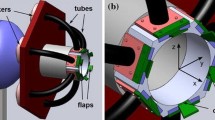Abstract
A novel method for the self-excitation of a flapping jet by a flexible film has been developed recently by Xu et al. (Exp. Ther. Fluid Sci. 2019, 106, 226–233). The present work is to advance our understanding of this kind of oscillating jets by experimentally examine their dependence on initial flow condition. Specifically, detailed investigations are made on characteristics of both film flutter and jet mixing due to initially distinct flow conditions made by circular nozzles of smooth contraction (SC), orifice plate (OP) and long pipe (LP). Present flapping jets are self-excited by a rectangular FEP film with one end fixed at the nozzle exit. Hot wire anemometry and laser-sheet flow visualization are adopted for the present experiments. Experimental results demonstrate that the film-flutter characteristics are considerably nozzle-dependent. In particular, the OP nozzle yields the largest film-flutter domain and the lowest energy loss for fluttering. It is also shown that the three nozzles’ flapping jets exhibit substantially different mixing characteristics due to their distinct initial conditions. Specifically, the OP jet exhibits the highest flapping Strouhal number, highest velocity decay rate, strongest relative turbulence intensity, and largest length scales of turbulence. And the flapping SC and LP jets are compatible in mixing characteristics. Relative to the conventional (non-flapping) free jets, all the present flapping jets entrain and mix the surrounding fluid at a much higher rate, consequently spreading and decaying far more rapidly. Importantly, when the flapping Srouhal number is sufficiently high or low, the small-scale mixing appears to be enhanced or depressed by the flapping in the near field and then maintain farther downstream.
Graphical abstract













Similar content being viewed by others
References
Antonia RA, Satyaprakash BR, Hussain AKMF (1980) Measurements of dissipation rate and come other characteristics of turbulent plane and circular jets. Phys Fluids 23:695–700
Burattini P, Lavoie P, Antonia RA (2005) On the normalized turbulent energy dissipation rate. Phys Fluids 17:098103
Crow SC, Champagne FH (1971) Orderly structure in jet turbulence. J Fluid Mech 48:547–591
Danaila I, Boersma BJ (2000) Direct numerical simulation of bifurcating jets. Phys Fluids 12:1255–1257
Davis MR (1982) Variable control of jet decay. AIAA J 20:606–609
Eloy C, Kofman N, Schouveiler L (2012) The origin of hysteresis in the flag instability. J Fluid Mech 691:583–593
Favre-Marinet M, Binder G, Hac TV (1981) Generation of oscillating jets. J Fluids Eng 103:609–613
Friehe CA, Van Atta CW, Gibson CH (1972) Jet turbulence: dissipation rate measurements and correlations. In: Turbulent shear flows, AGARD conference proceedings no. 93, 18–1
Glauser M, Walker S (1988) Active flow control to cut millions from jet engine life cycle costs. Air Force Res Lab Res Highlights, Sept/Oct 1998
Gohil TB, Saha AK, Muralidhar K (2015) Simulation of the blooming phenomenon in forced circular jets. J Fluid Mech 783:567–604
Hill WG, Greene PR (1977) Increased turbulent jet mixing rates obtained by self-excited acoustic oscillations. ASME J Fluids Eng 99:520–525
Manias CG, Nathan GJ (1993) The precessing jet gas burner a low NOx burner providing process efficiency and product quality improvements. World Cement (march) 1993:4–11
Mi J, Antonia RA (2001) Effect of large-scale intermittency and mean shear on scaling-range exponents in a turbulent jet. Phys Rev E 64:026302
Mi J, Nathan GJ (2010) Statistical properties of turbulent free jets issuing from nine differently-shaped nozzles. Flow Turbul Combust 84:583–606
Mi J, Nathan GJ, Luxton RE (2001a) Mixing characteristics of a flapping jet from a self-exciting nozzle. Flow Turbul Combust 67:1–23
Mi J, Nobes DS, Nathan GJ (2001b) Influence of exit conditions of round nozzles on the passive scalar field of a free jet. J Fluid Mech 432:91–125
Mi J, Nobes DS, Nathan GJ (2001c) Mixing characteristics of axisymmetric free jets issuing from a contoured nozzle, an orifice plate and a pipe. ASME J Fluids Eng 123:878–883
Mi J, Xu M, Zhou T (2013) Reynolds number influence on statistical behaviors of turbulence in a circular free jet. Phys Fluids 25:075101
Mi J, Nathan GJ, Luxton RE (2004) Oscillating jets, PCT/AU98/00959, US patent no. 6685102 (2004.2), European pat. no. 1032789 (2004.9)
Nathan GJ, Hill SJ, Luxton RE (1998) An axisymmetric ‘fluidic’ nozzle to generate jet precession. J Fluid Mech 370:347–380
Nathan GJ, Luxton RE (1991) Flame stability and emission characteristics of the enhanced mixing burner. The 2nd European conference on industrial furnaces and boilers, april. Portugal, Algarve
Païdoussis MP (2016) Fluid-structure interactions: slender structures and axial flow, vol 2. Elsevier, London
Parekh D, Leonard A, Reynolds WC (1983) A vortex-filament simulation of a bifurcating jet. Bull Am Phys Soc 28:1353
Raman G, Cornelius D (1995) Jet mixing control using excitation from miniature oscillating jets. AIAA J 33:365–368
Reynolds WC, Parekh DE, Juvet PJD, Lee MJD (2003) Bifurcating and blooming jets. Annu Rev Fluid Mech 35:295–315
Silva CBD, Métais O (2002) Vortex control of bifurcating jets: a numerical study. Phys Fluids 14:3798–3819
Simmons JM, Lai JCS, Platzer MF (1981) Jet excitation by an oscillating vane. AIAA J 19:673–676
Taneda S (1968) Waving motions of flags. J Phys Soc Jpn 24:392–401
Tyliszczak A (2015) LES-CMC of excited hydrogen jet. Combust Flame 162:3864–3883
Tyliszczak A, Geurts BJ (2014) Parametric analysis of excited round jets–numerical study. Flow Turbul Combust 93:221–247
Viets H (1975) Flip-flop jet nozzle. AIAA J 13:1375–1379
Wu M, Xu M, Mi J, Deo RC (2020) Mixing characteristics of a film-exciting flapping jet. Int J Heat Fluid Flow 82:108532
Xu M, Wu M, Mi J (2019) A new type of self-excited flapping jets due to a flexible film at the nozzle exit. Exp Therm Fluid Sci 106:226–233
Acknowledgements
The financial support of National Nature Science Foundation of China (Grant No. 11972048) is gratefully acknowledged.
Author information
Authors and Affiliations
Corresponding authors
Rights and permissions
About this article
Cite this article
Wu, M., Li, C., Zhu, C. et al. On flapping jets induced by a fluttering film and from circular nozzles of smooth contraction, orifice plate and long pipe. Exp Fluids 63, 81 (2022). https://doi.org/10.1007/s00348-022-03426-5
Received:
Revised:
Accepted:
Published:
DOI: https://doi.org/10.1007/s00348-022-03426-5




